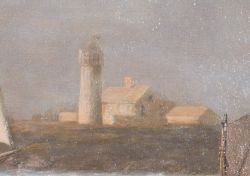loading 
Fitz Henry Lane
HISTORICAL ARCHIVE • CATALOGUE RAISONNÉ • EDUCATIONAL RESOURCE
An online project under the direction of the CAPE ANN MUSEUM
An online project under the direction of the CAPE ANN MUSEUM
Catalog entry
inv. 305
Sailing off the Maine Coast
Lumber Schooner off the Maine Coast with Lighthouse in the Distance
1850 Oil on canvas 25 x 35 3/4 in. (63.5 x 90.8 cm) Signed and dated lower right: F. H. Lane 1850
|
Supplementary Images
Provenance (Information known to date; research ongoing.)
The Artist, Gloucester, Massachusetts
Edward D. Peters, Boston, Massachusetts (sold to)
Mr. and Mrs. John R. Moot, Cambridge, Massachusetts (by descent)
Penobscot Marine Museum, Searsport, Maine
Exhibition History
DeCordova Museum, Lincoln, Massachusetts, Fitz Hugh Lane: The First Major Exhibition, March 20–April 17, 1966., no. 32.
Traveled to: Colby College Art Museum, Waterville, Maine, 30–6, 1966.
Traveled to: Colby College Art Museum, Waterville, Maine, 30–6, 1966.

Commentary
It is a late afternoon with a fresh westerly breeze as a lumber schooner with a full deck load tacks off Gloucester Harbor, about half a mile southeast of Eastern Point. We are looking due north and in the distance lays a passing bank of cumulus clouds, their western edges aglow with reflected sunlight.
Probably from Maine, the lumber schooner is bound for a port south of Cape Ann, such as Salem or Boston. The painting descended in the Peters family and was likely commissioned by Edward Dyer Peters, who made a fortune in the lumber business based out of Ellsworth, Maine and Boston. These humble lumber schooners where the basis of Peters' fortune delivering his products to Boston and ports south. Peters also commissioned another painting from Lane of Blue Hill, Maine where Peters had built a large mansion by the harbor.
Given her position relative to Eastern Point, this vessel is only passing by, not having left Gloucester Harbor or intending to enter it. Given also the wind direction, tacking inshore would be necessary to make port in the Boston Bay area. The schooner is deep-laden, responding slowly to the helm and back-winding her square topsail to hasten the process of coming-about. The maneuver is nearly complete; men can be seen standing on the deck load of lumber, hauling the port topsail yard braces while slacking the starboard braces to rotate the sail so it draws properly.
It is a different story with the other two schooners in this picture. The coasting schooner at right – also rigged with a square topsail – is leaving Gloucester Harbor, possibly with a load of dried codfish for the West Indies. Schooners rigged with square topsails – “tops’l schooners” for short – were used for longer coastal voyages, sailing further offshore where the square sail would steady the vessel’s motion in a seaway while adding sail area for more speed.
The schooner at far left is a banks fisherman of the “sharpshooter” type, her crew fishing at the rail with hand-lines on Georges Bank – 200 miles east of Cape Cod. On her stern davits is a yawl boat (no dories were carried) – used when in port or at sea as a lifeboat. Sharpshooters were so-called for their sharper-ended, faster hulls, using their speed to bring fresh fish (on ice in their holds) to market. When railroads reached Gloucester in the late 1840s, a whole new market for fresh fish was opened for inland cities and towns, encouraging the building of faster fishing vessels to get their catch to market as quickly as possible.
In the lower right corner is a yawl boat adapted for use along shore, having a mast and spritsail with the owner sitting aft, steering with rudder and tiller. He is likely a fisherman, working ‘longshore with hand-lines and baited hooks. These boats were also used for tending fish traps and gill-nets (see Gloucester Harbor, 1852 (inv. 38)).
While a Maine setting for this painting has been argued, the configuration of lighthouse, keeper’s house, and covered passageway, combined with its orientation to the late afternoon sun, make Eastern Point Light, Gloucester the most likely location.
–Erik Ronnberg